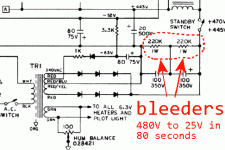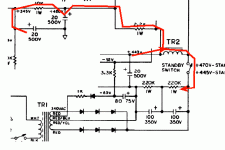Hi,
Im working on a silver face twin reverb from 1973. Ive replaced the 5 larger filter capacitors, powered the amp, checked some voltages, and discharged the capacitors. After that I put the capacitor cover back on and flipped it over.
My question is about discharging capacitors from the opposite side of the chassis. The two larger capacitors I discharged at one leg of the stand-by switch. I am studying the circuit to make sure I get all the discharging spots, but would appreciate any suggestions.
Thanks
Im working on a silver face twin reverb from 1973. Ive replaced the 5 larger filter capacitors, powered the amp, checked some voltages, and discharged the capacitors. After that I put the capacitor cover back on and flipped it over.
My question is about discharging capacitors from the opposite side of the chassis. The two larger capacitors I discharged at one leg of the stand-by switch. I am studying the circuit to make sure I get all the discharging spots, but would appreciate any suggestions.
Thanks
Attachments
is the concern of discharging simply a safety concern or is there some other reasoning for this?
seems to me that the original design does in fact have bleeder resistors across the main filters so is there a problem with those perhaps?
seems to me that the original design does in fact have bleeder resistors across the main filters so is there a problem with those perhaps?
Last edited:
Safety. If I don't discharge them the capacitors hold the high voltage for a while. I havent installed the tubes yet.
??? is this hearsay or a result confirmed with an actual measurement? and if so how long is a while?
Safety. If I don't discharge them....
THIS amplifier should self-bleed in less than 2 minutes.
Yes, ALL the high-voltage caps are connected to each other through the B+ string (if the SB switch is in PLAY). The bias supply is lower V and exposed on far fewer points, is not a danger in my opinion.
Attachments
Last edited:
Thank you for the replies.
Yes, the two 100uf capacitors do discharge within a couple minutes with the standby switch on. Would the the three 20uf 500v also be drained automatically? When I measured, those seemed to be discharging slower than the 100uf. Just want to make sure before I install the chassis into the cabinet and put the tubes back.
Yes, the two 100uf capacitors do discharge within a couple minutes with the standby switch on. Would the the three 20uf 500v also be drained automatically? When I measured, those seemed to be discharging slower than the 100uf. Just want to make sure before I install the chassis into the cabinet and put the tubes back.
i only see one in the schematic...where are the other two?
Attachments
On my valve amp designs I always include LED's in the power supply to show when voltage is high. Better safe than sorry or dead !
....Would the the three 20uf 500v also be drained automatically?....
Pretend the schematic is a road map. Can you get there from here?
Attachments
- Home
- Live Sound
- Instruments and Amps
- Fender Twin 1973


